Electronegativity Study guides, Class notes & Summaries
Looking for the best study guides, study notes and summaries about Electronegativity? On this page you'll find 1229 study documents about Electronegativity.
Page 4 out of 1.229 results
Sort by

-
Solution Manual for Organic Chemistry 7th Edition by Brown All Chapters
- Exam (elaborations) • 37 pages • 2023
-
- $19.99
- + learn more
Solution Manual for Organic Chemistry 7th Edition by Brown CHAPTER 1 Solutions to the Problems Problem 1.1 Write and compare the ground-state electron configurations for each pair of elements: (a) Carbon and silicon C (6 electrons) 1s 2 2s 2 2p 2 Si (14 electrons) 1s 2 2s 2 2p 6 3s 2 3p 2 Both carbon and silicon have four electrons in their outermost (valence) shells. (b) Oxygen and sulfur O (8 electrons) 1s 2 2s 2 2p 4 S ...
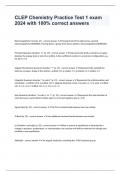
-
CLEP Chemistry Practice Test 1 exam 2024 with 100% correct answers
- Exam (elaborations) • 5 pages • 2024
-
- $16.49
- + learn more
Electronegativity trend (p. 21) - correct answer Moving from left to right across a period, electronegativity INCREASES. Moving down a group from top to bottom, electronegativity DECREASES. Principal Quantum Number: "n" (p. 19) - correct answer Represents the shell an electron occupies, denotes the energy level or size of an orbital. Is the coefficient number in an electron configuration e.g. for 3p^2, n=3 Angular Momentum Quantum Number: "l" (p. 19) - correct answer Represents the sub...

-
TEST BANK FOR Organic Chemistry 12th Edition By T. W. Graham Solomons, Craig B. Fryhle, Scott A. Snyder Chapter 1-25 | 2024-2025 (VERIFIED)
- Exam (elaborations) • 2299 pages • 2024
- Available in package deal
-
- $38.49
- + learn more
TEST BANK FOR Organic Chemistry 12th Edition By T. W. Graham Solomons, Craig B. Fryhle, Scott A. Snyder Chapter 1-25 | (VERIFIED) Which of the following best describes the origin of carbon atoms? a) The Big Bang b) amino acids found on meteorites c) byproduct of chemical fusion in stars d) gradual decay of radioactive isotopes of nitrogen e) All of these choices. Answer: C Topic: General Section: 1.1 Difficulty Level: Easy 2) Credit for the first synthesis of an organic compound from ...
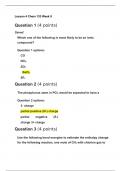
-
CHEM133 Week 9 Lesson 4 Quiz Questions and Answers APU
- Exam (elaborations) • 12 pages • 2023
- Available in package deal
-
- $23.99
- + learn more
1. Question: Which one of the following is most likely to be an ionic compound? 2. Question: The phosphorus atom in PCl3 would be expected to have a 3. Question: The phosphorus atom in PCl3 would be expected to have a give CH3Cl and hydrogen chloride. 4. Question: How many of the following molecules have no dipole moment? 5. Question: Atoms having equal or nearly equal electronegativities are expected to form 6. Question: Element A has an electronegativity of 0.8 and element B has an electr...
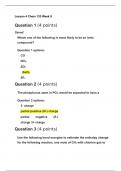
-
CHEM133 Week 9 Lesson 4 Quiz
- Exam (elaborations) • 12 pages • 2023
- Available in package deal
-
- $31.53
- + learn more
1. Question: Which one of the following is most likely to be an ionic compound? 2. Question: The phosphorus atom in PCl3 would be expected to have a 3. Question: The phosphorus atom in PCl3 would be expected to have a give CH3Cl and hydrogen chloride. 4. Question: How many of the following molecules have no dipole moment? 5. Question: Atoms having equal or nearly equal electronegativities are expected to form 6. Question: Element A has an electronegativity of 0.8 and element B has an electr...
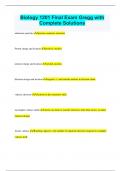
-
Biology 1201 Final Exam Gregg with Complete Solutions
- Exam (elaborations) • 31 pages • 2024
- Available in package deal
-
- $10.49
- + learn more
Biology 1201 Final Exam Gregg with Complete Solutions subatomic particles protons, neutrons, electrons Proton charge and location positive, nucleus neutron charge and location neutral, nucleus Electron charge and location negative (-) and outside nucleus in electron cloud valence electrons electrons in the outermost shell incomplete valence shells atoms can share or transfer electrons with other atoms, or make chemical bonds Atoms valence Bonding capacity = the number of...
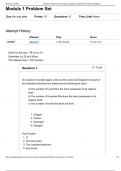
-
CHEM 219 Module 1 Problem Set: Principles of Organic Chemistry with Lab FALL 2023 Portage learning
- Exam (elaborations) • 18 pages • 2023
-
- $22.49
- + learn more
On a piece of scratch paper, write out the Lewis Dot Diagram for each of the indicated elements and determine the following for each: a) The number of Lone Pairs the atom possesses in its valence shell. b) The number of Unpaired Electrons the atom possesses in its valence shell. c) The number of bonds the atom will form. 1. Oxygen 2. Carbon 3. Hydrogen 4. Nitrogen 1. O 2. Two lone pairs 3. Two unpaired electrons 4. two bonds 12/14/23, 8:42 PM Module 1 Problem Set: Principles of Or...
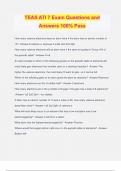
-
TEAS ATI 7 Exam Questions and Answers 100% Pass
- Exam (elaborations) • 18 pages • 2024
-
- $12.49
- + learn more
TEAS ATI 7 Exam Questions and Answers 100% Pass How many valence electrons does an atom have if the atom has an atomic number of 10? -Answer-8 valence e- because it ends with 2s2 2p6 How many valence electrons will an atom have if the atom is located in Group VIA of the periodic table? -Answer-VI=6 An atom located in which of the following groups on the periodic table of elements will most likely gain electrons from another atom in a chemical reaction? -Answer-The higher the valence elec...
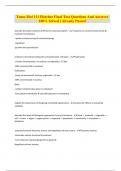
-
Tamu Biol 111 Fletcher Final Test Questions And Answers 100% Solved | Already Passed
- Exam (elaborations) • 33 pages • 2024
-
- $9.49
- + learn more
describe the basic functions all life forms must accomplish - -response to environmental stimuli & maintain homeostasis -uptake and processing of nutrients/energy -regulation -growth and reproduction compare and contrast eukaryotic and prokaryotic cell types - Prokaryotes: -circular chromosomes, no nucleus, no organelles, 3.5 bya -DNA concentrated in nucleoid Eukaryotes: -linear chromosomes, nucleus, organelles, 1.5 bya -DNA concentrated in nucleus Both: -cellular function takes plac...

How did he do that? By selling his study resources on Stuvia. Try it yourself! Discover all about earning on Stuvia



